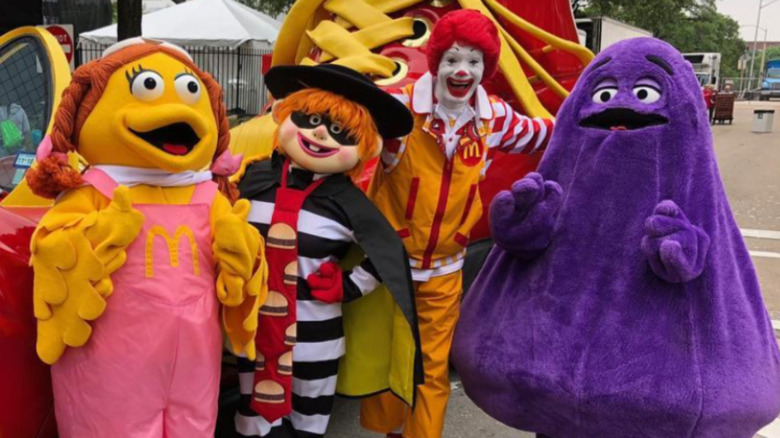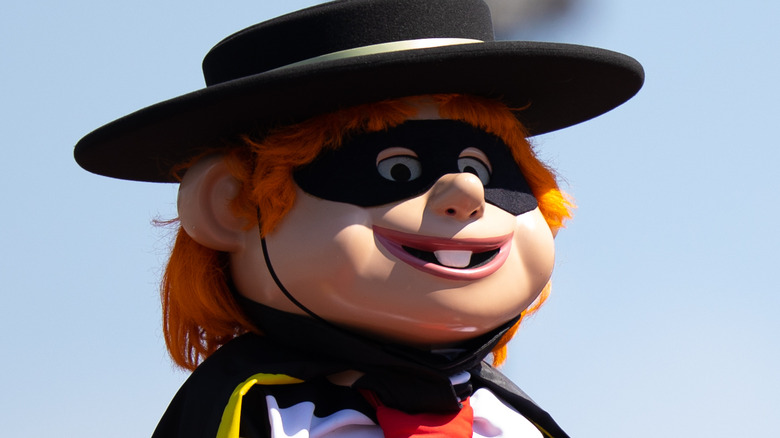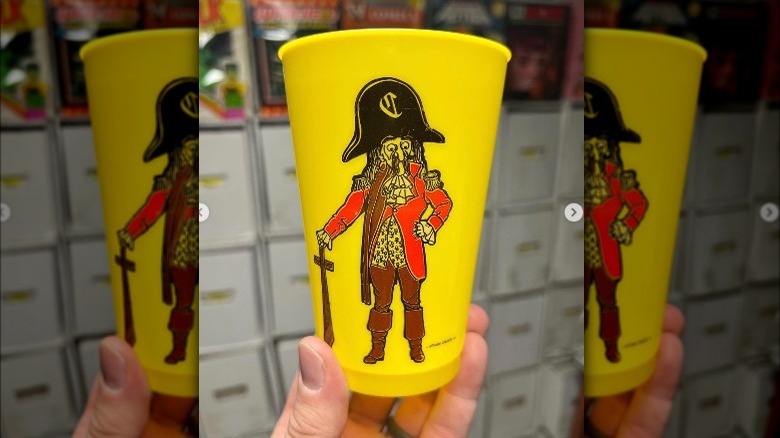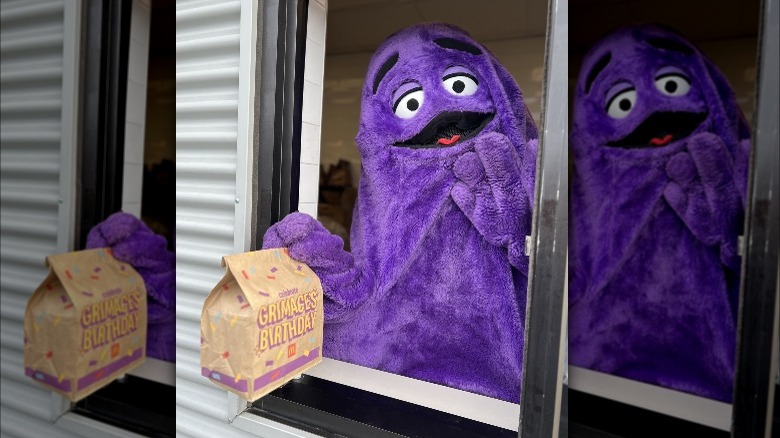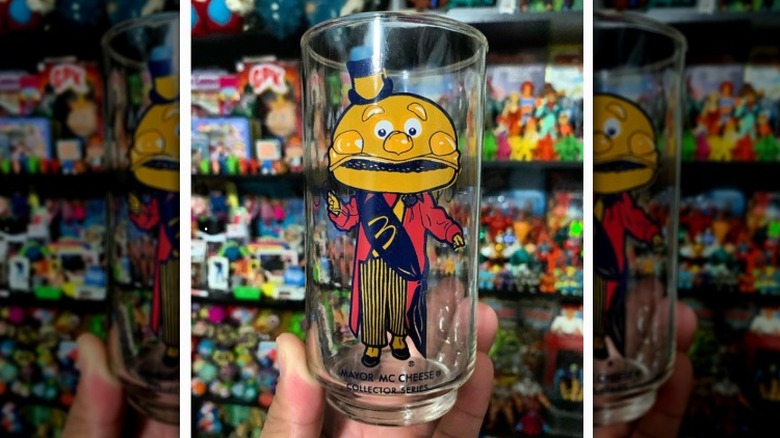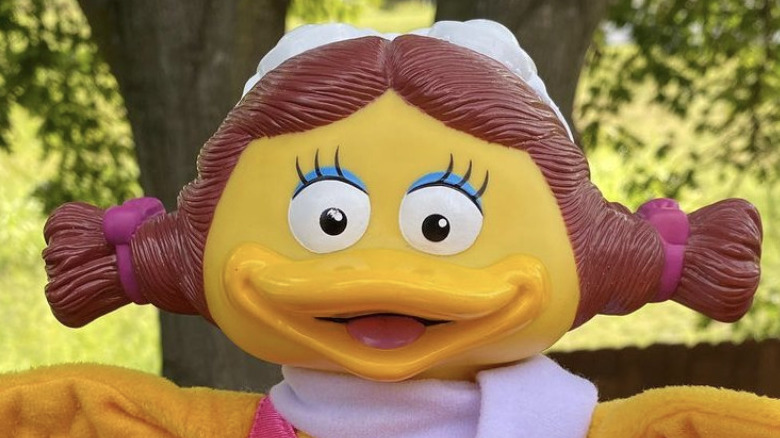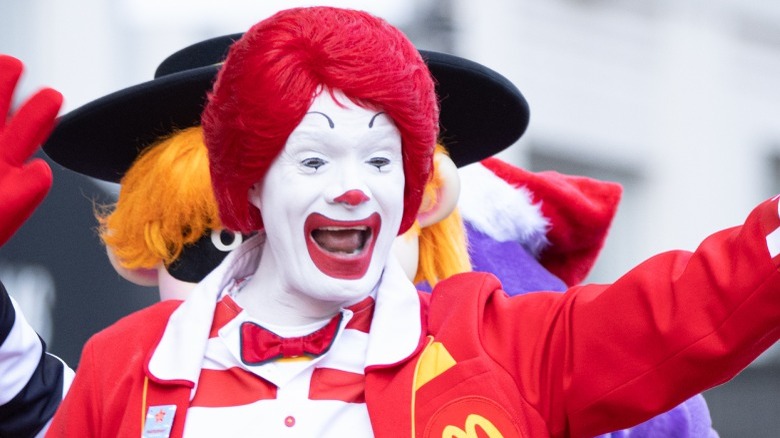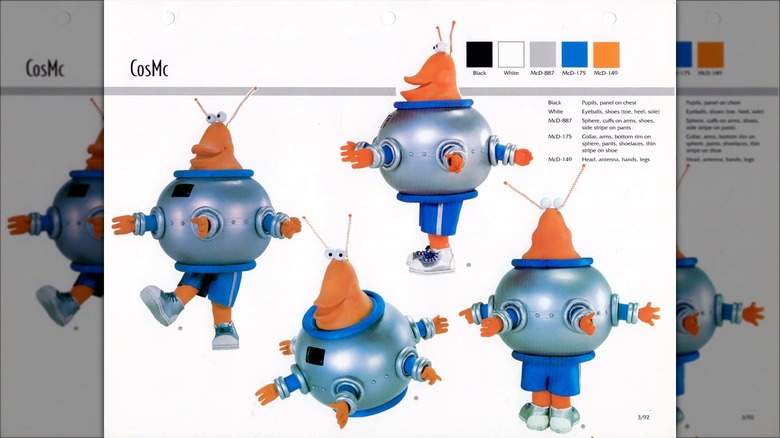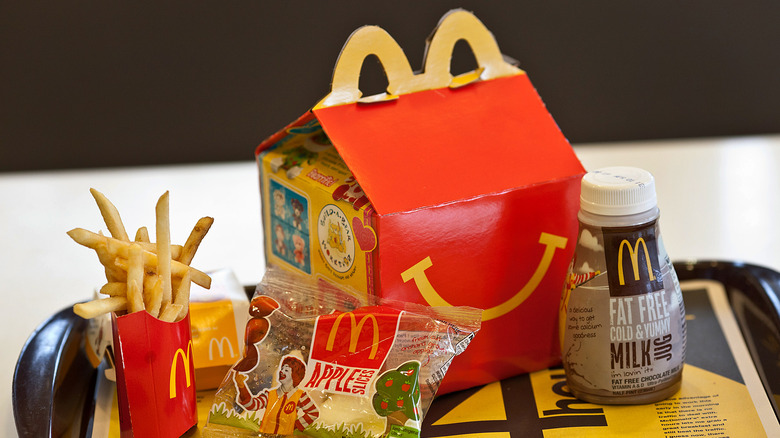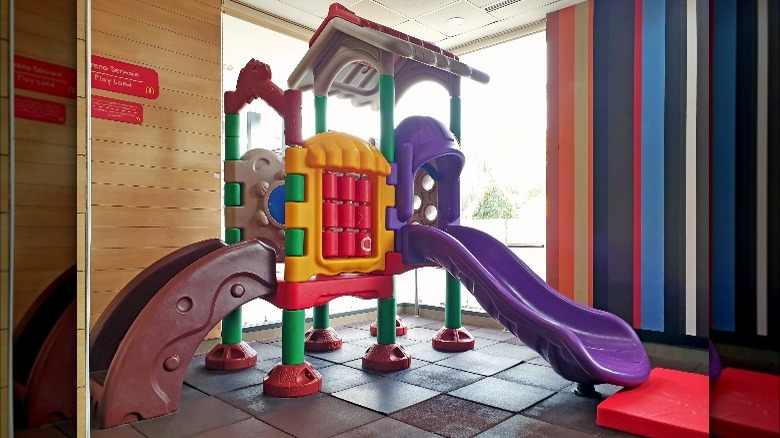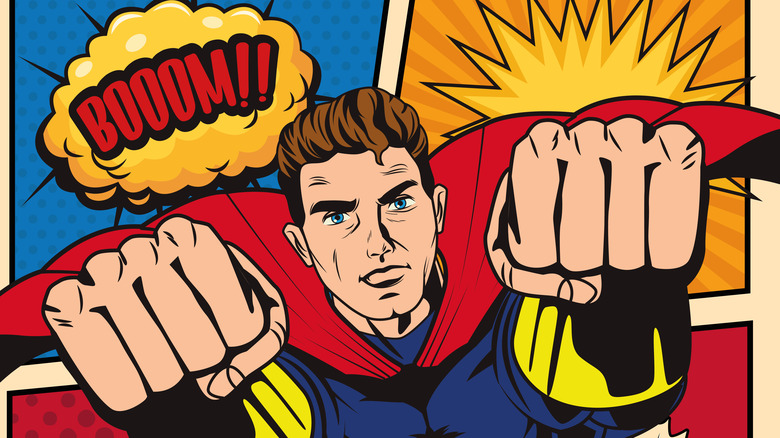What Really Happened To The McDonaldland Characters?
In the early 1970s, according to "Sid and Marty Krofft: A Critical Study of Saturday Morning Children's Television," McDonald's tasked advertising agency Needham, Harper & Steers with devising a television campaign to attract juvenile customers. The ad team came up with "McDonaldland," a fantastical world full of kid-friendly characters, both good and evil, whose lives revolved around McDonald's various offerings. Essentially a world built around the fast food chain's long-established mascot, company man and jolly clown Ronald McDonald, were allies like Mayor McCheese and Officer Big Mac, who helped him ward off thieves like the Hamburglar and Grimace. More characters would later join the fray, building up a sizable and vast McDonaldland universe.
Countless ads in the McDonaldland canon ran often on TV, primarily during time periods when lots of kids were watching, only for McDonald's to slowly phase out most of the characters and the whole fantastical premise in the 21st century. Here's how those advertising icons evolved over the years, as well as a look into just what went so wrong in McDonaldland.
A reboot didn't save the Hamburglar from second-fiddle status
The most notorious villain in McDonaldland has always been the Hamburglar, a fast food thief who dresses like an old-fashioned prison inmate in black and white stripes, and in a face-obscuring mask. The Hamburglar exists solely to steal hamburgers from Ronald McDonald and his friends, proudly taunting "Robble, Rooble!" as he does. But his most famous look, as a cartoonish, harmless villain with a smiling face and a cape, wasn't McDonald's first attempt at the character.
In the '70s, the Hamburglar was briefly known as the "Lone Jogger." He also sported just two teeth, had a hook nose, and made a choking-croaking noise. With an image both frightening and meaningless to children — the Lone Ranger reference was lost on kids who didn't grow up with that radio and movie character from the 40s and 50s — McDonald's softened the character in the 80s before he stopped being used in ads entirely in 2002.
In 2015, McDonald's confusingly attempted to rebrand the character as "sexy" -– portrayed not as a full-body costume but by a male actor with a scant face mask. This rebranding of a beloved children's character to a live-action adult was off-putting and short-lived. But in 2023, the Hamburglar returned once more in a new series of nostalgic TV commercials. These ads feature him as his more recognizable cartoonish self, back to his old devious ways: trying to steal McDonald's hamburgers.
Captain Crook and Officer Big Mac were victims of downsizing
While the Hamburglar survived until the 2000s, his partner in crime quickly and quietly disappeared in the 1980s. According to the McDonaldland Specification Manual (via Flickr), Captain Crook was part of the first round of characters. And as the Hamburglar preyed on land-based McDonald's food (beef), Captain Crook was forever in pursuit of purloined treats of the sea, the Filet-O-Fish. A stereotypical pirate later known as just The Captain, per Mental Floss, his image and character were softened from creepy bad guy into an innocuous, always-foiled villain. As McDonaldland proved to be overpopulated with characters, it lost a few members from the roster by the 1980s, among them Captain Crook, who didn't quite fit in with the kid-oriented ad campaign as a character who stole the adult-focused Filet-O-Fish sandwich.
Also around in the 1970s but gone by the 1980s owing to the McDonaldland simplification: Officer Big Mac. Named for McDonald's signature triple-decker, extra-large sandwich, the living burger figure was a police officer downright obsessed with stopping both Captain Crook and the Hamburglar. After both Officer Big Mac and Captain Crook made their abrupt exits from McDonaldland ads, Ronald McDonald dealt more directly with the Hamburglar, the sole remaining villain.
Grimace has a dark backstory
Many of the McDonaldland characters over the years were associated with the celebration of or passion for a particular menu item: Officer Big Mac, the McNugget Buddies, and the Fry Kids, for example. Also among the one-track-minded denizens of McDonaldland, at least at first, was Grimace. The amorphous, vaguely triangular glob of purple started out as Evil Grimace, and he was known for his unquenchable desire for McDonald's shakes.
Grimace's otherwise inscrutable appearance can be explained : Company lore says the character is supposed to look like a taste bud. When the character was revamped into that of one of Ronald McDonald's friends, his look got a makeover, too — he once had four arms (the better to hold more shakes with), and in later renditions possessed just two. Eventually, he was phased out of McDonald's ads -– but not for long.
In 2023, Grimace would return in a big way to celebrate his 52nd birthday –- and he brought his beloved McDonald's shakes back with him. In a viral ad campaign that swept through social media platforms, Grimace promoted his special Birthday Meal, which included the choice of a Big Mac or 10-piece Chicken McNuggets, a side of fries, and a Grimace Birthday Shake, which was just as purple as he is. The campaign spawned a line of Grimace-themed merch and even an online browser video game called "Grimace's Birthday".
Grimace had a family member make an appearance, too. Starting in 1975, Grimace's Uncle O'Grimacey would journey from his home in Ireland and visit his nephew around St. Patrick's Day. Luckily, that always coincided with the limited time run of the Shamrock Shake. The character was featured on cups, a balloon/hand puppet giveaway, and even made public appearances at some stores to promote the shake. Sometime in the '80s, Uncle O'Grimacey stopped traveling to McDonaldland altogether. In 2012, when CNN inquired with the company about his whereabouts, company spokeswoman Ashlee Yingling sadly replied, "We will not be bringing back Uncle O'Grimacey."
Mayor McCheese was legally forced to leave McDonaldland
McDonald's contracted the advertising agency Needham, Harper & Steers to create what would become the McDonaldland campaign. But early in the process in 1970, according to a lawsuit (via Justia), an executive with the agency contacted Marty Krofft of Sid and Marty Krofft, producers of multiple outrageous, fantastical, live-action 1970s Saturday morning TV shows, including "Sigmund and the Sea Monsters," "The Bugaloos," and "H.R. Pufnstuf." The Krofft organization met with the ad people several times, with the agency ultimately announcing that the McDonald's campaign they'd created art and engineering plans for had been canceled.
But then the McDonaldland commercials started airing in 1971, per the Chicago Reader, some of them produced by former Krofft employees. The Kroffts promptly sued, alleging copyright infringement, as there were many physical, stylistic, and thematic similarities between "H.R. Pufnstuf" and the McDonaldland ads. Pufnstuf was in charge of a fantasy world and sported a massive round head, not unlike McDonaldland's Mayor McCheese, who had a cheeseburger for a head. The courts found McDonald's liable, and not only did the company pay damages, but it also retired Mayor McCheese from the McDonaldland lineup.
Some McDonaldland characters didn't need to stick around
Beyond the enduring and most familiar core cast of Ronald McDonald, Grimace, and the Hamburglar, the McDonaldland landscape occasionally introduced other characters. Some of them served to flesh out the world and plots of commercials, while others' entire existence was tied to the promotion specific food items McDonald's was looking to heavily promote to kids. Some of these creatures and animals became long-running members of the McDonaldland crowd, while others proved not very effective movers of McDonald's product, and so they were quietly dropped from the decades-spanning ad campaign.
In 1980, the first female character arrived in McDonaldland — Birdie the Early Bird. Dressed like an old-fashioned aviator in a flight cap and scarf, she was introduced solely as a way to promote McDonald's then-new breakfast menu to young consumers. Birdie was an active part of McDonald's commercials for years, a main character comparable to Grimace or the Hamburglar and outlasting her initial McMuffin-promoting job. And so, when McDonald's phased out McDonaldland, there no longer really existed a pressing need for Birdie.
McDonald's didn't feel the need to save, in the short or long term, the characters of Sundae and The Professor either. The former was Ronald McDonald's pet dog, casually named after one of McDonald's dessert offerings, while the latter was a wacky inventor type who occasionally propelled the action in various ads.
The real reason McDonald's got rid of Ronald McDonald
As the host of a popular children's TV show and the figurehead of a fast food chain, Krusty on "The Simpsons" is a throwback to a time when circus clowns were popular children's entertainers, as well as a parody of McDonald's mascot (and "Chief Happiness Officer," according to LinkedIn) Ronald McDonald. As far as appealing to kids today, clowns are passé at best and terrifying at worst. Most 21st century pop culture clowns are frightening.
According to a 2014 Rasmussen poll (via NBC News) 43% of Americans feel an aversion toward clowns. A murderous clown named Twisty figured prominently in the "American Horror Story" anthology series in the mid-2010s, coinciding with a rash of ominous clown sightings around the U.S. in the summer of 2016. The horror-clown phenomenon got so bad that McDonald's scaled back on appearances by Ronald McDonald until the controversy died down. He was a clown, and at that time, Americans didn't want to see one.
McDonald's has since returned Ronald to active status. The character maintains a popular Instagram account detailing his many public appearances to promote McDonald's and the Ronald McDonald House charity. But McDonald's TV commercials are a different story. In the 2020s, the company has relied on marketing tactics like combo meals assembled by celebrities, and hiring "Succession" star Brian Cox to narrate a series of ads.
A star is reborn with CosMc
One the latest McDonaldland characters to be introduced was an alien that had the working name of Otto Control. An elevator company already had dibs on the name, so the character was given the more playful name of "CosMc." In 1987, future "Bad Santa" actor Tony Cox donned the CosMc costume and this high flying "flower pot" with six orange arms, googly eyes, and antenna appeared on the scene. According McDonaldland Specification Manual, "CosMc is a wacky, fun-loving guy who causes mischief — but it's not intentional, just a result of his misunderstanding of Earth customs and practices."
CosMc quickly learned from Ronald McDonald and friends how delicious McDonald's food was, and soon earned his own colorful namesake Crayola-branded Happy Meal. In the early '90s, he and Ronald appeared in the Nintendo game M.C. Kids, as well as made rounds at local schools to impress upon the importance of reducing, reusing, and recycling.
While CosMc's time on planet Earth seemed to come to an end shortly after, apparently he was busy whipping up new concoctions truly out of this world. In 2023, McDonald's introduced a new restaurant concept name in his honor. According to CosMc's about page, he returned to "let humans order exactly what they crave with their own unique spin. To lift them up, just like the aliens. And to provide a momentary escape for anyone on their way through the galaxy."
McDonaldland was linked to childhood obesity
In 2002 and 2003, right around the time that McDonald's decided to more actively court adult customers rather than children, the fast food conglomerate dealt with a lawsuit, with plaintiffs alleging that the fast food establishment, along with Burger King and others, was culpable in the rising levels of kids living at an unhealthy weight, according to CNN. In August 2002, the families of two teenagers considered overweight by mainstream medical standards sued McDonald's, accusing the company of failing to properly tell the masses that its food packed considerable amounts of sugar, fat, and salt, which in turn led to their daughters' obesity-related health issues, including high blood pressure, high cholesterol, and heart disease. "We are not looking to get rich from a large money settlement," the plaintiffs' attorney, Samuel Hirsch, told CNN. "We are proposing a fund that will educate children about the nutritional facts and contents of McDonald's food."
A New York judge dismissed the suit, but McDonald's didn't emerge from the matter unscathed. The accusations put a spotlight on McDonald's food and business practices and led many to consider that the company's offerings weren't the healthiest choices. It would have been tough for McDonald's to continue to market to kids in the same ways that it had been, with cheerful, food-celebrating characters.
So, it launched the "Go Active" campaign, emphasizing exercise and moderation, according to Chief Marketer. As the McDonaldland characters were associated with the old food and the old ways, they didn't much factor into "Go Active," whose ads found Ronald McDonald playing sports with professional athletes.
McDonald's wanted to prove its maturity
The entire McDonaldland canon, characters, lore, history, and settings were designed and developed over the years with the aim of appealing to children, so as to make McDonald's seem like a wonderful, fantastical place to eat and spend money. About 30 years after its early 1970s launch, McDonald's started a long process of phasing out the McDonaldland campaign because the whole thing had worked too well — by the 21st century, McDonald's food was commonly thought of as food for children (and adults with uncomplicated tastes). According to CNN, in the 1990s, McDonald's fast food competitors like Burger King, Wendy's, and Taco Bell found a niche via counter-marketing, positioning themselves as destinations for budget-conscious adult eaters. McDonald's lost more ground and market share to upscale, grown-up chains, like Panera.
In response in 2003, McDonald's attempted a soft reboot, scaling back on opening new stores and launching a new focus on food quality. All that meant less marketing to kids and promoting juvenile-skewing foods like Happy Meals and Chicken McNuggets. McDonald's sought to prove it was growing up, and so it downplayed the child-centric marketing involving clowns, food burglars, and monsters.
McDonaldland playgrounds were a legal liability
McDonald's didn't just brand itself as a haven for kid-friendly food — it promoted its restaurants as places where children could hang out and have fun, surrounded by the same McDonaldland imagery from TV commercials. A PlayPlace could be found on the grounds of any one of thousands of McDonald's outlets — mini playgrounds where kids could jump, climb, and mess around with other kids, surrounded by the smiling illustrations of Ronald McDonald and his cohorts on posters or from the structures themselves. The equipment was sometimes made in the image of McDonaldland characters, like Officer Big Mac Climb-In Jail and the Hamburglar Swing.
By the mid-1990s, a couple of standard play pieces were removed from PlayPlaces: the Tug-N-Turn and the Big Mac Climber. By 1999, it became clear why McDonald's got rid of those structures. That year, according to the South Florida Sun-Sentinel, the U.S. Consumer Product Safety Commission fined McDonald's $4 million, the organization's largest punishment in history to that point. Apparently, over the previous 20 years, more than 400 kids had sustained injuries while playing on (or falling off) the Big Mac Climber, and McDonald's had neglected to report those injuries to authorities.
According to Eater, the number of families with kids going to McDonald's altogether declined in the 2010s, so PlayPlaces fell into disuse. Around that time, McDonald's embarked on a $6 billion nationwide store remodeling drive (via QSR), eliminating many McDonaldland-oriented PlayPlaces altogether.
The slow demise of Saturday morning cartoons helped kill McDonaldland
In 1996, the Federal Communications Commission moved to more strictly enforce the 1990 Children's Television Act, a system of media regulatory laws that would require commercially-supported broadcast networks to program a minimum of three weekly hours of educational television geared toward young viewers. Many outlets opted to logically put those newly mandated shows onto their Saturday morning lineups, supplanting the traditional lineup of purely entertainment-oriented cartoons.
The Children's Television Act also notably curtailed advertising, limiting ad space on Saturday morning TV to 10½ minutes per hour. That removed about six hourly minutes of advertising from that child-oriented time, meaning the companies that usually bought commercial time during that period — selling toys, cereals, or, in the case of McDonald's McDonaldland commercials, fast food hamburgers — suddenly had a whole lot less space to work with.
All those new rules ultimately proved to be more trouble than they were worth for the networks. With NBC the first to eliminate cartoons in favor of teen-oriented sitcoms, news, and sports, all the major broadcast networks would eventually give up on animated fare on weekend mornings altogether, programming educational and informational shows about travel and animals. With the Saturday morning cartoon landscape receding, McDonald's lost one of its most crucial McDonaldland promotional haunts.
McDonald's was lovin' a new strategy featuring Justin Timberlake
Monumental cultural shifts and changing business strategies led to the demise and downplaying of the use of the McDonaldland universe of characters in McDonald's marketing plans. By 2003, when the big fadeout of Ronald McDonald's friends began, the company had entrusted two large companies with its advertising. In 1981, per The New York Times, McDonald's dropped McDonaldland creator Needham, Harper, and Steers in favor of Chicago-based Leo Burnett Company, but in 1997, according to the Los Angeles Times, brought back Needham to regroup after a poor sales period led to major internal management changes.
Per Chicago Magazine, McDonald's launched the "I'm Lovin' It" campaign in 2003, perceived as a hip and modern advertising approach, addressed to potential customers of all ages, and built around a jingle sung by pop star Justin Timberlake (to whom McDonald's paid $6 million for his services), and based on a successful campaign in German-language areas of Europe. Burnett led the campaign in the English-speaking world, and Needham's corporate siblings directed the operation in German-speaking countries. "I'm Lovin' it" became one of McDonald's longest-running and most successful advertising blitzes ever, running for more than a decade and thereby replacing the McDonaldland characters.
